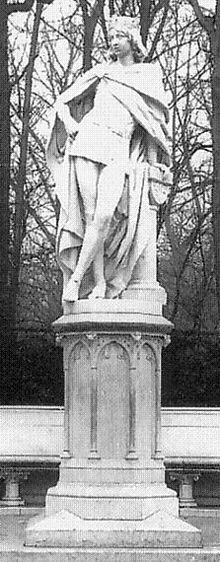Henry II, Margrave of Brandenburg-Stendal
Henry II | |
|---|---|
| Margrave of Brandenburg-Stendal | |
 Statue in the former Siegesallee in Berlin, 1900 | |
| Born | c. 1308 |
| Died | July 1320 Bärwalde, Neumark |
| Noble family | House of Ascania |
| Father | Henry I, Margrave of Brandenburg-Stendal |
| Mother | Agnes of Bavaria |
Henry II of Brandenburg-Stendal, nicknamed Henry the Younger or Henry the Child (Template:Lang-de; c. 1308 – July 1320) was the last Margrave of Brandenburg from the House of Ascania.
Life
Henry's parents were Margrave Henry I of Brandenburg-Stendal and Agnes, a daughter of the Wittelsbach duke Louis II of Bavaria. Henry II had three older sisters.[1]
In 1319, at the age of 11, Henry II was to succeed his cousin, Margrave Waldemar, who had died childless. The Pomeranian duke Wartislaw IV took the occasion to set himself up as regent and used this position to promote his own interests in the long-time Brandenburg–Pomeranian conflict. In turn, Henry's Ascanian relative, Duke Rudolph I of Saxe-Wittenberg intervened and tried to take over the regency. King Louis IV, half-brother of Henry's mother Agnes, finally declared him an adult, though he did not enfeoff him with Brandenburg.
Henry's early death in 1320 prevented him from acting independently, moreover, it also meant the end of the Brandenburg line of the Ascanian dynasty. As a completed fief, the Margraviate fell back to the Wittelsbach king Louis IV, who enfeoffed his eldest son Louis V (called "the Brandenburger") with Brandenburg in 1323.
Statue

A statue of Henry II by the sculptor August Kraus (1868-1934) was unveiled on 22 March 1900 on the former Siegesallee boulevard in Berlin. Kraus used the young French cellist Paul Bazelaire, who happened to be visiting Berlin, as a model for the statue. Together with busts of Henry's guardian, Duke Wartislaw IV of Pomerania and the knight Wedigo von Plotho (modeled on Kraus' friend Heinrich Zille), it formed statue group #9.
Severely damaged in World War II, the statue is currently on display at the Spandau Citadel.
Ancestry
See also
References
- Johannes Schultze (1969), "Heinrich II. das Kind", Neue Deutsche Biographie (in German), vol. 8, Berlin: Duncker & Humblot, pp. 349–349; (full text online)
Footnotes
- ^ Medieval Lands Project: Brandenburg, Ch. 3, viewed on 24 June 2011
